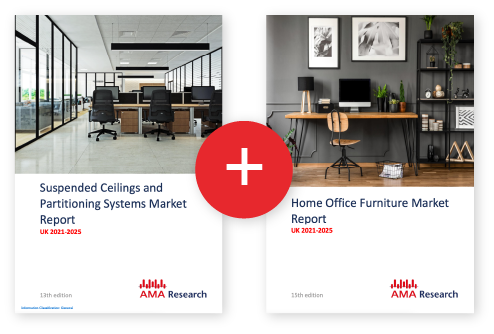Office Furniture Dealers Market Report – UK 2017-2021
Available as an Instant Download PDF
The 7th edition of the Office Furniture Dealers Market Report UK 2017-2021 has been published by AMA Research. The report This report incorporates original research and provides an up-to-date, practical review of the office furniture dealer channel, analysing market size, structure, recent and future trends as well as the dealer buying process. The accompanying Office Furniture Dealers Database UK 2017, includes additional fields such as contact names, e-mail addresses and dealer activities. This substantial database comprises around 540 leading UK office furniture dealers. Detailed market data and insight on the office furniture dealers market by AMA Research, a leading UK provider of construction market intelligence.
£1,599.00 Exc. VAT
The 7th edition of the ‘Office Furniture Dealers Market Report – UK 2017-2021’ incorporates original research and provides an up-to-date, practical review of the office furniture dealer channel, analysing market size, structure, recent and future trends as well as the dealer buying process.
Key issues covered in the report:
- Review of the dealer channel.
- Dealer buying process.
- Sourcing criteria for dealers.
- The office furniture market.
Areas of particular interest include:
- Performance of the dealer channel in recent years.
- Key criteria influencing selection of office furniture suppliers.
- Key influences on decision making process in supplier selection.
- Detailed market data and insight on the office furniture dealers market by AMA Research, a leading UK provider of construction market intelligence.
Some of the companies included:
Addvance Business Solutions, Alpha Office Furniture, Alpha Office Interiors (MK), Amaryllis, Andrews Office Furniture, Axis Storage and Interiors Solutions, Banner Group, Bilfinger Europa Facility Management, Calibre Office Furniture & Interiors, Canary Wharf Contractors (CWCL), Claremont Group Interiors, Como Interiors, D & G Office Interiors, Dale Office Interiors, Hunts Office Furniture and Interiors, Insightful Environments UK, InteriorsTeam, IOR Group, ISG Fit Out, Maris Interiors, MJF Interiors, Morgan Sindall Group, Morgan Lovell, Oktra, Paramount Office Interiors, Parkeray, Showcase Interiors, Space Efficient interiors Style Office Systems, Structure Tone London, The TSK Group, The Furniture Practice, Tsunami Axis, Wagstaff Bros, Yes 2 Solutions.
Dealer characteristics
- Review of the office furniture dealer channel – recent performance, size, trends and influencing factors.
- Forecasts of future size of the dealer channel to 2021 – factors affecting future performance.
- Profiles of leading office furniture dealers – background, financial information etc.
- Analysis of dealers’ facilities – percentages, trends etc.
- Review of dealers’ customer bases – major customer groups, percentages, trends etc.
- Review of dealers’ sales and marketing methods – types, trends, manufacturer support.
Dealer buying & specification process
- Analysis of sourcing of office furniture – major channels, supplier mix, number of suppliers, current trends etc.
- Review of buying groups – usage, trends and profiles of leading organisations.
- Key influencers on the decision-making process for supplier selection.
- Review of information sources used when reviewing suppliers – and the key factors considered when making that decision.
- Analysis of supplier review periods among dealers.
- In depth review of key influencing factors on supplier selection – such as quality, product range, price, delivery lead times, marketing and technical support etc.
Overall office furniture market
- Overview of office furniture market – analysis of size by value, current situation and historical trends. Factors currently affecting the market and reasons for recent lack of growth.
- Review of international trade in office furniture – trends in imports and exports by product group.
- Review of distribution channels for office furniture – structure, distribution mix etc.
- Overview of furniture manufacturers – market position, analysis of activities, financial information etc.
The steady increase in the office furniture dealers’ market since 2012 has largely been the result of buoyant growth in the UK economy and strong recovery in office construction, rising business confidence and the surge in quality fit-out projects. Within the construction sector the level of activity in the office new build sector has been rising as firms continue to grow in confidence, with the level of vacant office space falling significantly, particularly in the City, a major source of demand for office furniture.
The two main distribution channels for office furniture are via the dealer network, accounting for around 45% of the market, and direct sales to end users. Office furniture dealers have lost share within the office furniture market as companies seek to reduce costs by dealing directly with the manufacturers. The growth of the Internet, particularly e-auctions and e-procurement has had a negative impact on the office furniture dealers’ market, with this distribution channel providing cost savings. A large proportion of home office furniture is supplied in flat pack form by specialist manufacturers and importers and sold through retail furnishing outlets such as Argos and IKEA.
There are three main categories of companies active in this market; commercial refurbishment and fit out companies; pure office furniture dealers; and general refurbishment and fit out operations. The office furniture dealers’ market is extremely fragmented with over 2,000 companies operating in the UK, largely single branch enterprises. Whilst supply capacity pressures has resulted in some consolidation, supply continues to exceed demand, maintaining high levels of competition.
Despite recent solid growth, prospects for the office furniture sector are less certain. The continuing uncertainties regarding the form and process of Brexit are not currently conducive to speculative or substantial investment in new commercial premises. Therefore, it is likely that institutional investment in office building will fall in the short-medium term. Other factors that could constrain growth include competition for increasingly scarce development land across Greater London and change of use development. Over the next 4 years, the market is forecast to show modest growth with rates of 1-3% per annum likely.
- Contents Listing
- 1. INTRODUCTION 6
- 1.1 BACKGROUND 6
- 1.2 SOURCES OF INFORMATION 6
- 2. SUMMARY & MARKET PROSPECTS 8
- 2.1 SUMMARY 8
- 2.2 MARKET PROSPECTS 9
- 3. ECONOMIC ENVIRONMENT 11
- 3.1 GDP 11
- 3.2 INFLATION & INTEREST RATES 13
- 3.3 UNEMPLOYMENT 14
- 3.4 HOUSEHOLD CONSUMPTION 14
- 3.5 HOUSING & CONSTRUCTION 15
- 3.6 STERLING 16
- 3.7 POPULATION PROFILE 17
- 3.8 CONCLUSIONS 17
- 4. OFFICE FURNITURE DEALER MARKET 19
- 4.1 MARKET DEFINITION & STRUCTURE 19
- 4.2 MARKET SIZE & TRENDS 21
- 4.2.1 Current Market 21
- 4.2.2 Market Prospects 23
- 4.3 KEY MARKET INFLUENCES 24
- 4.3.1 Office Furniture Market 24
- 4.3.2 Construction Output 33
- 4.3.3 Commercial Office Sector 34
- 4.3.4 International Trade 36
- 5. OFFICE FURNITURE DEALERS 38
- 5.1 CHARACTERISTICS & TRENDS 38
- 5.2 MARKET SHARES 41
- 5.3 OFFICE FURNITURE DEALER COMPANY PROFILES 42
- 5.3.1 Major Commercial Refurbishment and Fit-out Companies 42
- 5.3.2 Major Office Furniture Dealers 44
- 5.3.3 Major General Refurbishment and Fit-out Specialists 45
- 5.4 OTHER DISTRIBUTION CHANNELS 46
- 5.4.1 Buying Groups 46
- 5.4.2 Direct 47
- 5.4.3 Mail Order/Online 47
- 5.4.4 Retail Outlets 50
- 6. THE BUYING, SPECIFICATION AND SOURCING PROCESS 51
- 6.1 OVERALL VIEW 51
- 6.2 SOURCE OF SUPPLIES 52
- 6.3 BUYING PROCESS 54
- 6.4 FACTORS INFLUENCING CHOICE OF SUPPLIER 55
- 6.5 MAJOR CUSTOMER GROUPS 60
- Tables and Charts
- CHART 1: UK OFFICE FURNITURE DEALERS MARKET SIZE AND FORECASTS 2012-2021 BY VALUE (£M MSP) 8
- TABLE 2: GDP DATA – 2013-2016 – KEY CONSTITUENT ELEMENTS 12
- CHART 3: INTEREST RATES AND INFLATION (CPI) FROM 2000-2021 13
- CHART 4: PDI & SAVINGS RATIO AT CURRENT PRICES 2000-2021 15
- TABLE 5: EXCHANGE RATE FLUCTUATIONS 2012-2019 – STERLING TO THE DOLLAR, AND THE EURO, SPOT RATES 16
- CHART 6: OFFICE FURNITURE – DISTRIBUTION STRUCTURE 19
- TABLE 7: UK OFFICE FURNITURE DEALERS’ MARKET SIZE 2012-2021 (£M MSP) 21
- TABLE 8: UK MARKET FOR OFFICE FURNITURE 2012-2016 (£M MSP) 25
- TABLE 9: MARKET SHARE OF LEADING OFFICE FURNITURE SUPPLIERS 2016 % BY VALUE 27
- CHART 10: SHARE OF MARKET HELD BY 6 LEADING OFFICE FURNITURE SUPPLIERS (%) 28
- CHART 11: CONSTRUCTION OUTPUT (GREAT BRITAIN) NEW WORK & RMI – CURRENT PRICES (£BN) 2012 -2021 33
- CHART 12: NON-RESIDENTIAL CONSTRUCTION OUTPUT NEW WORK ANALYSIS BY SECTOR 2016 AND 2021 – % BY VALUE GB 34
- TABLE 13: NON-DOMESTIC CONSTRUCTION OUTPUT OFFICES, RETAIL AND INDUSTRIAL GB 2012-2021 – BY VALUE (£BN) 35
- CHART 14: CENTRAL LONDON OFFICE MARKET – OFFICE TAKE UP (MILLION SQ. FT) 36
- TABLE 15: UK IMPORTS AND EXPORTS OF OFFICE FURNITURE 2014-2016 (£M) 37
- TABLE 16: UK IMPORTS & EXPORTS OF OFFICE FURNITURE BY PRODUCT 2014-2016 (£M) 37
- CHART 17: DISTRIBUTION CHANNEL SHARE BY VALUE – OFFICE FURNITURE 2016 (%) 38
- CHART 18: DEALERS’ SHARE OF THE UK OFFICE FURNITURE MARKET 1997 – 2016 (%) 39
- CHART 19: SHARE OF OFFICE FURNITURE DEALERS’ MARKET BY CATEGORY 2016 (COMMERCIAL FIT-OUT, GENERAL FIT=OUT, OFFICE FURNITURE DEALERS) 41
- CHART 20: AVERAGE NUMBER OF CORE FURNITURE SUPPLIERS PER DEALER (%) 51
- CHART 21: PROPORTION OF DEALERS SOURCING FROM EACH TYPE OF SUPPLIER (%) 52
- TABLE 22: PROPORTION OF TURNOVER GENERATED FROM EACH TYPE OF SUPPLIER 2003-2010-2016 (%) 53
- TABLE 23: KEY INFLUENCE ON CHOICE OF SUPPLIER 54
- TABLE 24: MAIN SOURCES OF INFORMATION USED WHEN SEEKING A SUPPLIER (%) 55
- TABLE 25: OVERALL RANKING OF FACTORS INFLUENCING DEALERS CHOICE OF SUPPLIER 56
- CHART 26: MAJOR MARKETING METHODS USED BY DEALERS (%) 61

Paired Report Discount
Save £250 for every two reports you buy
Discount applied in basket
Frequently bought together

Trusted by industry leaders
For more detailed requests speak to our research experts directly
Research you can depend on
Our reports go deeper to give you the insights needed to make your next strategic move.
- Detailed assessment of the market – analysis of the market structure and recent developments within the market.
- Market prospects up to 4 years – market value, opportunities, impact of Covid-19, Brexit etc.
- Detailed information – market size, influences, market factors and key players.
- Analysis by product group – market size, product mix, sector trends etc.








